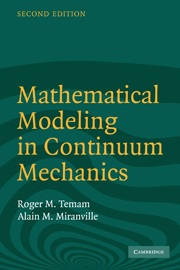Book contents
- Frontmatter
- Contents
- Preface
- A few words about notations
- PART I FUNDAMENTAL CONCEPTS IN CONTINUUM MECHANICS
- PART II PHYSICS OF FLUIDS
- PART III SOLID MECHANICS
- 13 The general equations of linear elasticity
- 14 Classical problems of elastostatics
- 15 Energy theorems, duality, and variational formulations
- 16 Introduction to nonlinear constitutive laws and to homogenization
- 17 Nonlinear elasticity and an application to biomechanics
- PART IV INTRODUCTION TO WAVE PHENOMENA
- Appendix: The partial differential equations of mechanics
- Hints for the exercises
- References
- Index
15 - Energy theorems, duality, and variational formulations
Published online by Cambridge University Press: 06 July 2010
- Frontmatter
- Contents
- Preface
- A few words about notations
- PART I FUNDAMENTAL CONCEPTS IN CONTINUUM MECHANICS
- PART II PHYSICS OF FLUIDS
- PART III SOLID MECHANICS
- 13 The general equations of linear elasticity
- 14 Classical problems of elastostatics
- 15 Energy theorems, duality, and variational formulations
- 16 Introduction to nonlinear constitutive laws and to homogenization
- 17 Nonlinear elasticity and an application to biomechanics
- PART IV INTRODUCTION TO WAVE PHENOMENA
- Appendix: The partial differential equations of mechanics
- Hints for the exercises
- References
- Index
Summary
In this chapter, we present some principles of energy minimization that characterize equilibria in elastostatics; we also introduce two related concepts, namely the concept of duality (duality for the variational principles and duality between displacements and stresses), and the concept of variational formulations. Apart from their relevance to mechanics, these concepts also play an important role in the numerical approximation of the problems we consider (but we do not address this here of course), and, in other related forms, in many other areas of science.
Elastic energy of a material
In an isotropic elastic material, we can define a quadratic functional w = w(ε), called the energy function, such that:
for every tensor field ε, and thus Eq. (15.1) is then identical to the stress–strain law of the material. This function is thus defined by
hence,
or else
Consequently, w is a positive definite quadratic form in ε (we will always assume that μ and κ = λ + 2μ/3 are strictly positive).
If we now consider a tensor field ε defined on, we can associate with it the functional
We have the following result, which provides a physical interpretation of W and justifies its introduction:
Proposition 15.1.We consider an elastic system S that is in its natural state (ε = 0) and fills the volume Ω at time t = 0 and that is at time t = t1in the deformation state corresponding to the deformation tensor ε. Then, –W(ε) is, to first approximation, the work of the internal forces between times 0 and t1. Thus, W(ε) is the amount of energy stored in stresses between 0 and t1.
- Type
- Chapter
- Information
- Mathematical Modeling in Continuum Mechanics , pp. 235 - 247Publisher: Cambridge University PressPrint publication year: 2005

